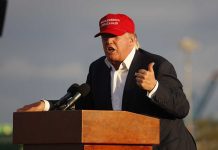
Pentagon revokes Gen. Mark Milley’s security clearance and launches investigation into potential demotion amid controversy over his actions during Trump administration.
Top Takeaways
- Defense Secretary Pete Hegseth revokes Gen. Mark Milley’s security detail and clearance
- Pentagon orders investigation into Milley’s conduct, potentially leading to rank demotion
- Milley’s portraits removed from Pentagon, raising questions about his legacy
- Trump-Milley relationship strained over calls to Chinese counterpart and handling of protests
- Move seen as part of broader effort to restore accountability in Defense Department
Milley’s Security Clearance Revoked, Investigation Launched
In a significant development, Defense Secretary Pete Hegseth has revoked the security clearance and detail for retired Gen. Mark Milley, the former Chairman of the Joint Chiefs of Staff. This action comes as part of a broader investigation into Milley’s conduct during his tenure, particularly focusing on allegations that he may have disrupted the chain of command during the Trump administration.
The Pentagon’s chief of staff, Joe Kasper, emphasized the importance of this move, stating “Undermining the chain of command is corrosive to our national security, and restoring accountability is a priority for the Defense Department under President Trump’s leadership.”
This statement underscores the seriousness with which the current administration is approaching potential breaches in military protocol and chain of command.
🚨MASSIVE BREAKING:
Defense Secretary Pete Hegseth has REVOKED General Mark Milley's security detail and security clearance.
Hegseth is now planning on DEMOTING the General.
Hegseth also ordered the removal of all Pentagon portraits of Milley.
Total Humiliation pic.twitter.com/ZtKpzyw2n9
— Benny Johnson (@bennyjohnson) January 28, 2025
Potential Demotion and Removal of Portraits
The investigation goes beyond the revocation of security clearance. The Defense Department’s Inspector General has been directed to review Milley’s actions to determine if a demotion in retirement rank is warranted. This unprecedented move could potentially strip Milley of a star, significantly impacting his legacy and retirement benefits.
“The inspector general review will include “an inquiry into the facts and circumstances surrounding Gen Milley’s conduct so that the Secretary may determine whether it is appropriate to reopen his military grade review determination,” said Pentagon spokesman John Ullyot.
Adding to the controversy, Milley’s portraits are being removed from the Pentagon. One portrait was taken down shortly after Trump’s inauguration, and another in the Marshall Corridor is slated for removal. These actions have fueled public speculation about Milley’s standing within the military community and the current administration.
Strained Relationship with Trump and Controversial Calls
At the heart of this investigation are Milley’s actions during the Trump administration, particularly his calls to Chinese Gen. Li Zuocheng without Trump’s knowledge. These calls, reportedly made to assure China of U.S. stability and non-aggression, were detailed in the book “Peril” by Bob Woodward and Robert Costa. Trump has vehemently criticized these actions, even suggesting they could amount to treason.
The relationship between Milley and Trump had been fraught with tension, exacerbated by disagreements over the response to the George Floyd protests and the events of January 6th at the Capitol. Milley’s public criticisms of Trump, including derogatory remarks reported in Bob Woodward’s book, further strained their relationship.
Broader Implications for National Security
This investigation into Milley is part of a larger trend affecting former Trump appointees. Milley is the fourth official to lose security detail and clearance, following Mike Pompeo, John Bolton, and Brian Hook. These officials had been under protection due to threats from Iran, partly related to their involvement in the 2020 drone strike on Qassem Soleimani.
The Pentagon has not officially commented on these developments, maintaining silence on the ongoing investigative process. However, the actions taken against Milley signal a significant shift in how the current administration is addressing perceived breaches of military protocol and chain of command.
As this situation unfolds, it raises important questions about military leadership, civilian control of the armed forces, and the delicate balance of power within the highest echelons of the U.S. defense establishment. The outcome of this investigation could have far-reaching implications for future military leaders and their interactions with civilian leadership.






















